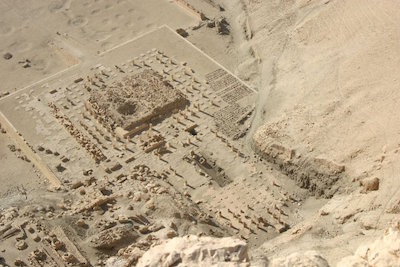Nebhepetre Montuhotep (Montuhotep II, Mentuhotep II, also sometimes known as Montuhotep I) was the first ruler of the Eleventh Dynasty who reunified the country after the First Intermediate Period. Montuhoptep followed his predecessor’s example and combined his mortuary temple and tomb into one building.
He chose not to build a “saff” tomb (“Saff” is Arabic for “row” – early Eleventh Dynasty were cut into the rock in rows) preferring instead a bold new design. The temple-tomb was named “Akh Sut Nebhepetra” (“Splendid are the places of Nebhepetre”) and was the first monument to be constructed in Deir el-Bahri. Although it is a great deal smaller than Hatshepsut’s Mortuary Temple it clearly formed the inspiration for its design.

- Outer courtyard
- Ramp
- Inner core / pyramid
- Tombs of royal women
- Eighteenth dynasty chapel of Hathor
- Kings tomb
- Peristyle court
- Hypostle hall
- Sanctuary
- Statue room
A one hundred and fifty foot processional causeway connected a small valley temple (which has been destroyed) with the tree-lined court of the temple which was surrounded by walls on three sides. A T-shaped terrace was built using masonry and by using the natural rock. The walls built on this terrace were then decorated both inside and out with painted relief carving. It is argued by some that a small pyramid was constructed on the terrace because the Abbott Papyrus refers to the monument using the word for “pyramid” (“mr”). However, it is now generally agreed that the structure could not have supported this weight and it is also proposed that the word “mr” could also mean “tomb”.

An opening in the eastern side of the courtyard named “Bab el-Hosan” (“Gate of the Horseman” – the name refers to the fact that Howard Carter found the opening when his horse stumbled on it) leads to a number of unfinished chambers which are thought to have been intended as the pharaoh’s tomb. A seated statue of the king was discovered in one of these chambers by Howard Carter.
On the western side of the courtyard an orchard of tamarisk and sycamore trees was planted beside the ramp leading to the terrace. At the back of the forecourt and terrace there are colonnades decorated with images of processions, hunts and scenes showing the king’s military achievements. A number of statues of the Twelfth Dynasty king Senusret III were also found in this area.
A colonnaded ramp lead to the upper terrace which had its own colonnade on three sides. In the centre of the terrace stands a large square funerary chapel surrounded by octagonal columns. Along the west wall there are a number of shrines and tombs for the pharaoh’s wives and daughters (who were also priestesses of Hathor). Six sarcophagi were excavated from these tombs, each formed by six large slabs pinned together at the corners by metal braces.
In the centre of the court the entrance to the burial shaft for Mentuhotep’s tomb begins as a rectangular trench. The trench becomes a tunnel through the rock of the mountain, the first part of the tunnel clad in sandstone with niches that once held wooden human models showing them working in bakeries, granaries, and ships. His burial chamber contained an alabaster shrine in which the wooden coffin of Montuhotep II was placed.
Behind the chapel was a peristyle court (one with an open colonnade) and hypostyle hall cut into the living rock and featuring a small shrine in which an image of the king stood. This area was dedicated to the cult of the king and included a burial shaft leading directly into his tomb with a shrine which once held the wooden coffin of the king.
The temple was closely connected with the cult of Ra and the resurrection of the king and so it faces east to greet the rising (resurrected) sun. The temple front was constructed from limestone and dedicated to Montu–Ra who was the local deity of Thebes before Amun rose to prominence in the area. The back of the temple was constructed from sandstone and was dedicated to the king.
Bibliography
- Kathryn Bard (2008) An introduction to the Archaeology of Ancient Egypt
- B.J. Kemp (1991) Ancient Egypt: anatomy of a civilization
- G. Callender (2003) “The Middle Kingdom Renaissance” in Oxford History of Ancient Egypt. Edited by I Shaw
- Nigel & Helen Strudwick (1999) Thebes in Egypt
Copyright J Hill 2010